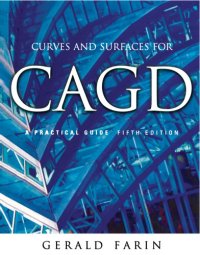
Ebook: Curves and Surfaces for CAGD: A Practical Guide
Author: Gerald Farin
- Genre: Physics // Quantum Physics
- Tags: Drafting Presentation Architecture Arts Photography CAD Solidworks Graphics Design Computers Technology Desktop Publishing Multimedia DirectX Flash GIS OpenGL Solid Works Programming Structured Software Testing Engineering Structural Civil Environmental Transportation Mathematics Applied Geometry Topology History Infinity Mathematical Analysis Matrices Number Systems Popular Elementary Pure Reference Research Study Teaching Transformations Trigonometry Science Math Visualization Computer New Use
- Series: The Morgan Kaufmann Series in Computer Graphics
- Year: 2001
- Publisher: Morgan Kaufmann
- Edition: 5th
- Language: English
- pdf
This fifth edition has been fully updated to cover the many advances made in CAGD and curve and surface theory since 1997, when the fourth edition appeared. Material has been restructured into theory and applications chapters. The theory material has been streamlined using the blossoming approach; the applications material includes least squares techniques in addition to the traditional interpolation methods. In all other respects, it is, thankfully, the same. This means you get the informal, friendly style and unique approach that has made Curves and Surfaces for CAGD: A Practical Guide a true classic.
The book's unified treatment of all significant methods of curve and surface design is heavily focused on the movement from theory to application. The author provides complete C implementations of many of the theories he discusses, ranging from the traditional to the leading-edge. You'll gain a deep, practical understanding of their advantages, disadvantages, and interrelationships, and in the process you'll see why this book has emerged as a proven resource for thousands of other professionals and academics.
* Provides authoritative and accessible information for those working with or developing computer-aided geometric design applications.
* Covers all significant CAGD curve and surface design techniques-from the traditional to the experimental.
* Includes a new chapter on recursive subdivision and triangular meshes.
* Presents topical programming exercises useful to professionals and students alike.
* Offers complete C implementations of many of the book's examples via a companion Web site.
I read the book over several days then experimented with the knowledge I had gained by upgrading my reusable C++ Finite State Machine classes to add a subset of the most useful heirarchical state machine features. All the debugging, banging and refitting I did to my classes gave me an appreciation for how much easier it would be to code and maintain statecharts using the author's pre-selected ideas and coherant, maintainable, elegant framework. My legacy design is about 180 degrees from the authors, using state objects (e.g.: I used nouns, and the author uses verbs) and all my functionality is set in externally through event and transition functions. Even using the book from that divergent viewpoint, the book's information and method of presentation was very useful. On the logic side, I'm reimplementing some standalone FSM algorithms using my new statechart capabilities and I appreciate the grounding in practical statechart design I received from this book. This includes a basic set of the most useful and powerful features and an understanding of how to implement more complicated special purpose features if I should ever decide I need them, and also an understanding of why I may never choose to do so.